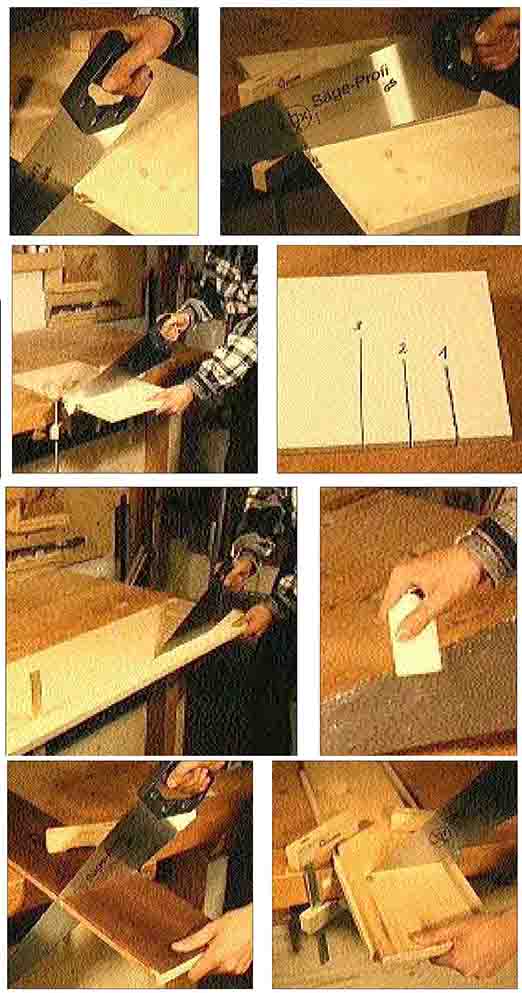 Marking and sawing
Marking and sawing
You should only use a pencil when drawing on wood, because the ink from both ballpoint and felt-tip pens soaks into the wood. When sawing, the saw is first pulled at as flat an angle as possible, to make a guide notch. Since the saw cut always "steals" material in the same size as the saw blade, must always be sawed outside of the crack.
The first moves with the handsaw
To get a guide for the sheet, the first lines of the saw are cut into the wood by slowly pulling it towards you. The thumb placed above the teeth can help, to hit the desired point on the wood. So that the cut runs straight and parallel to the marked line, when sawing from above, you aim at this line over the blade. Corrections by hand change the sawing direction.
To make the guide notch in the wood, only guide the sheet without pressure by pulling it.
So that the saw doesn't jump, at least three teeth should be in mesh when first cutting. Always saw in falling wood.
To get a clean cut edge, the saw must be guided in even, long strokes.
This is what the underside of the wood looks like when the saw is at different angles: 1 = 90°, 2 = 45°, 3 = 20-25°.

It is recommended for long separating cuts, Use a wedge to prevent jamming at the start of the cut.
So that fine-toothed and closely set saws cannot get stuck in the saw cut, clean the leaf well and coat it with wax.
Hold the scrap on the last few saws, so that the corner does not break when falling.
A base made of waste wood secures the saw edge and at the same time protects the workbench or work table.
When the saw jams
Because wood always strives, to contract again, can, especially with longitudinal cuts, clamp the saw blade. Resin nests in the wood or too narrow a set of teeth also slow down the saw blade. That is why it should always be clean and shiny. Resin and glue residue can be removed with white spirit, Rust with fine steel wool. Hand saws are always stored hanging and a cardboard slipcase protects the blade from contact with other tools.
Saw guide
When sawing, the saw blade should not be pulled back and forth in short strokes, but always be used in its full length. The pressure on the teeth increases from the tip of the blade to the handle. You should use the entire arm length and the upper body for power transmission. To prevent the underside of finely structured or coated panels from breaking, a saw that is as finely toothed as possible must be used and this must be guided evenly at as flat an angle as possible.
The last train
Many a workpiece was destroyed during the last sawing move. Because there are only a few wood fibers left, can easily tear the corner out. Therefore, the workpiece should always be clamped in the workbench or with clamps on the work table. So you have one hand free, to hold the scrap in place, before it breaks off. It is advisable for thin boards, clamp them together with a piece of scrap wood and saw through both parts together. So no cut can fail.